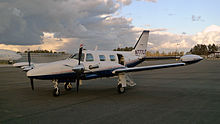| PA-31T Cheyenne | |
|---|---|
%2c_Luxembourg_PP1267311070.jpg) | |
| PA-31T1 Cheyenne in landing configuration | |
| Role | Turboprop |
| Manufacturer | Piper Aircraft |
| First flight | 29 August 1969 |
| Produced | 1974–1985 |
| Number built | 823 |
| Developed from | Piper PA-31 Navajo |
| Variants | Piper PA-42 Cheyenne |
The Piper PA-31T Cheyenne is a turboprop development of the earlier PA-31P Pressurized Navajo.
Development
Originally, the aircraft was an upgraded version of the Pressurized Navajo equipped with two Pratt & Whitney Canada PT6A-28 turboprop engines. Later, the aircraft was further refined and developed, including aerodynamic improvements and fuselage extensions. The PA-31T led to the development of the PA-42 Cheyenne III and IV.
Operators
Military operators
Variants
- PA-31T Cheyenne
- Initial production version, powered by two 620-shp (462-kW) Pratt & Whitney Canada PT6A-28 turboprop engines.
- PA-31T-1
- Original designation of the PT-31T Cheyenne I. Powered by 500-shp (373-kW) Pratt & Whitney Canada PT6A-II turboprop engines.
- PA-31T Cheyenne II
- Improved version, renamed version of original powered by two 620-shp (462-kW) Pratt & Whitney Canada PT6A-28 turboprop engines.
- PA-31T2 Cheyenne IIXL
- Stretched version, powered by two 750-shp (559-kW) Pratt & Whitney Canada PT6A-135 turboprop engines.
Specifications
Data from Jane's All the World's Aircraft 1976–77 [3]
General characteristics
- Crew: 2
- Capacity: 4–6 passengers
- Length: 34 ft 8 in (10.57 m)
- Wingspan: 42 ft 8 1&fras1;4 in (13.011 m) (over tip tanks)
- Height: 12 ft 9 in (3.89 m)
- Wing area: 229 sq ft (21.3 m2)
- Airfoil: NACA 632-415 at root, 63A212 at tip
- Empty weight: 4,870 lb (2,209 kg)
- Max takeoff weight: 9,000 lb (4,082 kg)
- Fuel capacity: 382 US gal (318 imp gal; 1,450 L) usable fuel
- Powerplant: 2 × Pratt & Whitney Canada PT6A-28 turboprops, 620 shp (460 kW) each
- Propellers: 3-bladed Hartzell HC-BTN-3B constant-speed propellers, 7 ft 9 in (2.36 m) diameter
Performance
- Maximum speed: 326 mph (525 km/h, 283 kn) at 11,000 ft (3,400 m)
- Cruise speed: 244 mph (393 km/h, 212 kn) at 25,000 ft (7,600 m) (econ. cruise)
- Stall speed: 88 mph (142 km/h, 76 kn) (flaps down)
- Range: 1,702 mi (2,739 km, 1,479 nmi) (econ. cruise, 45 min reserves)
- Service ceiling: 29,000 ft (8,800 m)
- Rate of climb: 2,800 ft/min (14 m/s)
- Takeoff run to 50 ft (15 m): 1,980 ft (600 m)
- Landing run from 50 ft (15 m): 1,860 ft (570 m)
See also
Related development
Aircraft of comparable role, configuration, and era
- Beechcraft King Air
- Cessna 425
- Cessna 441 Conquest II
- Mitsubishi Mu-2
References
- ^ "World Air Forces 1987 pg. 72". flightglobal.com. Retrieved 3 April 2019.
- ^ Tom, Kaminsky (2000). The United States military aviation directory. Airtime Publishing Inc. ISBN 978-1-880588-29-1.
- ^ Taylor, John W.R. (1976), Jane's All The World's Aircraft 1976–77, London: Jane's Yearbooks, pp. 358–359, ISBN 0-354-00538-3
